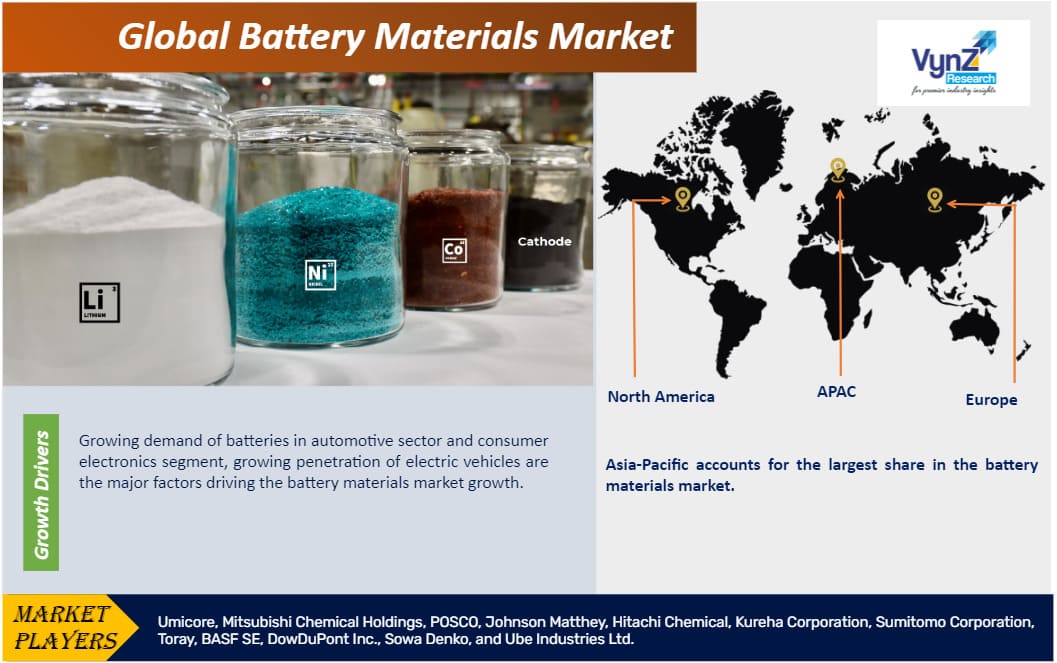Industry Overview
Battery materials are used in the batteries manufacturing. Various materials are used in manufacturing for different rechargeable batteries. The continuous growth in portable electronics and change in the motor vehicle industry is going to have a strong impact on the battery materials demand, particularly in developing countries. The global battery materials market is growing at a significant pace in recent years. The need of improved batteries at a lower cost, improved capacity retention and other factors are driving the market growth across the world.

Battery Materials Market Segmentation
Insight by Battery Type
Based on battery type, the battery material market is segmented into lead-acid and lithium-ion. The lead-acid battery type held the larger share in the market, which is attributed to the increasing use of these batteries in backup power, utilities, emergency lighting, security systems, oil and gas explorations, renewable energy systems, and others. Also, the renewability factor is also contributing in the market growth, as batteries are extensively used for the renewable energy storage and increasing investment in the renewable energy is driving the demand of these materials for battery manufacturing.
Insight by Application
Based on application, the battery materials market is segmented into automotive, electric vehicles, portable devices, and industrial. The automotive industry is the largest consumers of batteries, making it the major consumer of battery materials, thus the category hold the largest share in the market..
However, during the forecast period, the electric vehicle category is anticipated to witness the fastest growth in the market, owing to the growing penetration and adoption of electric vehicles in the developed countries, which is further contributing in the market growth. This can also be attributed to the growing environmental concerns and stringent rules and regulation imposed on the use of fuel and vehicles in the North American and European countries.
Global Battery Materials Market Report Coverage
|
Report Metric
|
Details
|
|
Historical Period
|
2018 - 2023
|
|
Base Year Considered
|
2024
|
|
Forecast Period
|
2025 - 2030
|
|
Market Size in 2024
|
U.S.D. xx Billion
|
|
Revenue Forecast in 2030
|
U.S.D. xx Billion
|
|
Growth Rate
|
xx%
|
|
Segments Covered in the Report
|
By Battery Type, and By Application
|
|
Report Scope
|
Market Trends, Drivers, and Restraints; Revenue Estimation and Forecast; Segmentation Analysis; Impact of COVID-19; Companies’ Strategic Developments; Market Share Analysis of Key Players; Company Profiling
|
|
Regions Covered in the Report
|
North America, Europe, Asia-Pacific, Middle East, and Rest of the World
|
Industry Dynamics
Battery Materials Market Growth Drivers
Growing demand of batteries in automotive sector and consumer electronics segment, growing penetration of electric vehicles are the major factors driving the battery materials market growth. The demand of smart devices, consumer electronics is increasing at a fast rate in the market which is acting as a growth driver in the global market. The demand of consumer electronics is mainly driven by the increasing working population, rising household incomes, expanding middle class, and increasing disposable income, resulting in increasing batteries demand, which in turn is driving the demand of materials used in battery manufacturing.
Battery Materials Market Challenges
Increasing raw material prices for batteries such as magnesium lead, cobalt, and lithium is identified as a major challenge in the growth of battery materials market.
Recent Developments By the Key Players
Sumitomo Corporation and Shingo Ueno has signed a memorandum of understanding (MOU) with Arelac, Inc. dba Fortera. The MOU focuses on a feasibility study to construct a commercial scale low-carbon cement plant in Japan. The project will be pursued in collaboration with Sumitomo Osaka Cement Co., Ltd.
Toray Industries announced that Toray Plastics (China) Co. will establish a new production site for resin-compounds in southern China.
Battery Materials Market Industry Ecosystem
Battery materials market is a high growth market displaying a huge growth prospects in the coming years. Various manufacturing companies, battery makers, research institutions, and others are investing heavily to bring technological advancement in batteries. The major players in the lithium-ion battery market in terms of value are Samsung SDI, LG Chem, SONY, ATL, Tesla, and others.
Battery Materials Market Geographic Overview
Asia-Pacific accounts for the largest share in the battery materials market, due to the rising demand of battery energy systems in the developing countries such as China and India. Also, the use of batteries is increasing for the purpose of renewable energy storage which is among the major factors influencing the battery materials market growth in the region, as the Asian countries are investing significantly in developing renewable energy resources. Additionally, with the rise in population of these countries, the demand of electronic devices such as tablets, smartphones, laptops, and others are also increasing at a fast rate, which is also driving the market growth in the region.
Also, at the global level, the materials have high demand and the manufacturing of these material is led by the Asian countries such as China, Japan, South Korea, and others. The industry players are looking for cheap materials due to the demand of low-cost batteries, thus, the players are shifting their bases to Asia-Pacific in order to take advantage of low-cost labor and cheap raw material.
Battery Materials Market Competitive Insight



